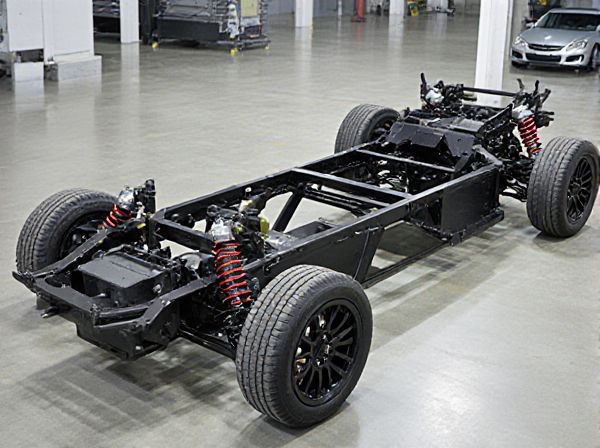
Photo illustration: Rolling Chassis vs Glider Chassis
A rolling chassis includes the vehicle's frame, engine, transmission, suspension, and wheels, ready to be driven or further customized. A glider chassis comes without the engine and transmission, allowing you to install your preferred powertrain for specialized applications. Choosing between them depends on whether you want a complete platform or a customizable base tailored to your needs.
Table of Comparison
| Feature | Rolling Chassis | Glider Chassis |
|---|---|---|
| Definition | Complete chassis with engine, transmission, and drivetrain installed | Chassis with frame and suspension only; engine and drivetrain must be installed separately |
| Engine Inclusion | Included | Excluded |
| Drivetrain | Pre-installed | Not included |
| Customization | Limited to body and accessories | High flexibility in engine and drivetrain choice |
| Use Case | Quick vehicle assembly and deployment | Engine replacement and rebuild projects |
| Cost | Higher due to engine and drivetrain | Lower initial cost, but added installation expenses |
| Common Applications | New vehicle production, fleet assembly | Engine upgrades, restorations, custom builds |
Introduction to Rolling Chassis and Glider Chassis
A rolling chassis consists of a fully assembled vehicle frame with the suspension, axles, wheels, and drivetrain but typically lacks the cab and body. A glider chassis, in contrast, is a frame equipped with essential running gear but intentionally excludes the engine, transmission, and sometimes the rear axles, allowing buyers to install refurbished or custom powertrains. Both options cater to different custom build needs in commercial vehicle manufacturing and fleet optimization.
Defining Rolling Chassis: Key Components
A rolling chassis includes the frame, engine, transmission, suspension, and wheels, providing a fully functional foundation for vehicle assembly. It enables manufacturers to simplify the production process by delivering a complete, operational base that requires only the addition of the body. Key components such as axles, drivetrain, and brake systems are integrated, distinguishing it from a glider chassis, which lacks an engine and transmission.
Understanding Glider Chassis: Main Features
Glider chassis come without key drivetrain components such as the engine, transmission, and rear axles, allowing buyers to install their preferred powertrain, which offers flexibility and cost savings. These chassis are primarily used for truck rebuilding or customization, enabling businesses to extend vehicle life or tailor performance specifications. Rolling chassis, by contrast, are fully assembled with drivetrain parts included, making glider chassis a preferred choice for operators seeking customizable heavy-duty truck solutions.
Core Differences Between Rolling Chassis and Glider Chassis
Rolling chassis includes a fully assembled frame with the engine, transmission, and wheels mounted, ready for immediate vehicle body installation, while glider chassis lacks the engine and transmission, providing only the frame and running gear. The core difference lies in the presence of critical powertrain components; rolling chassis simplifies assembly by delivering major mechanical systems pre-installed, whereas glider chassis requires installing these components separately. This distinction impacts cost, customization options, and vehicle build time, as rolling chassis offers a near-complete setup and glider chassis supports integrating refurbished or preferred powertrain parts.
Advantages of Rolling Chassis in Vehicle Manufacturing
Rolling chassis offers significant advantages in vehicle manufacturing by providing a fully assembled and road-ready platform that includes the frame, engine, suspension, and drivetrain components. This ready-to-use configuration reduces assembly time and labor costs, accelerates production cycles, and ensures greater consistency in build quality. Manufacturers benefit from streamlined operations and improved customization options, allowing faster integration of specialized bodies or equipment.
Benefits of Glider Chassis for Fleet Owners
Glider chassis offer fleet owners significant cost savings by allowing the reuse of existing powertrains, reducing initial investment expenses. Their flexibility in customization enables tailored configurations to meet specific operational requirements, enhancing efficiency and performance. Maintenance and repair costs decrease as familiar engines and transmissions are reused, improving overall fleet uptime and profitability.
Environmental Impact: Rolling vs Glider Chassis
Rolling chassis typically incorporates new, factory-built frames and axles, resulting in optimized emissions control and improved fuel efficiency compared to glider chassis, which reuse older vehicle components. Glider chassis, often utilized to refurbish existing vehicles by installing new cabs and bodies on pre-owned frames, may incorporate older engine technology that fails to meet current environmental standards, leading to higher emissions. Selecting rolling chassis supports stricter regulatory compliance and reduced environmental footprint due to advanced engine designs and enhanced durability.
Cost Comparison: Rolling Chassis vs Glider Chassis
Rolling chassis typically incur higher initial costs due to including a complete drivetrain and cab, whereas glider chassis are more cost-effective by recycling existing engine, transmission, and rear axles. Glider chassis leverage refurbished powertrain components, reducing expenses significantly but might pose higher maintenance risks over time. Choosing between rolling and glider chassis depends on balancing upfront investment against potential long-term operational costs and warranty considerations.
Common Applications and Use Cases
Rolling chassis are frequently used in commercial trucking and bus manufacturing, providing a fully assembled frame with engine, transmission, axles, and suspension, ready for customization with various body types. Glider chassis are preferred in vehicle refurbishment and fleet renewal projects, allowing the reuse of existing powertrain components by supplying only the frame, suspension, and wheels, reducing costs and environmental impact. Both chassis types support large vehicle configurations but differ in flexibility and application based on operational needs and budget constraints.
Choosing the Right Chassis for Your Needs
Choosing the right chassis depends on your project requirements and customization level. A rolling chassis offers a complete frame with essential components like axles and suspension, ideal for quick vehicle assembly and reliability. In contrast, a glider chassis provides a bare frame without drivetrain parts, allowing for tailored powertrain installation and flexibility in vehicle specifications.
 caratoz.com
caratoz.com